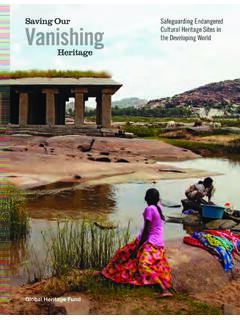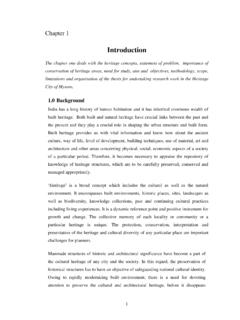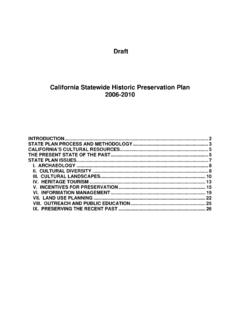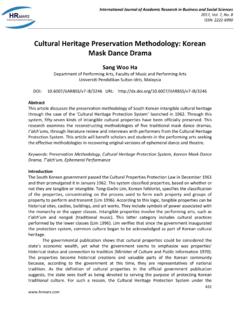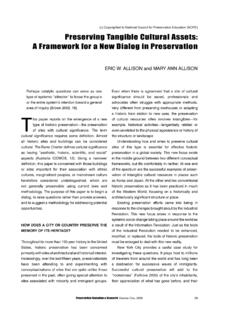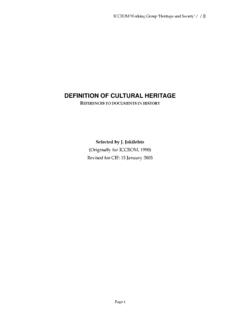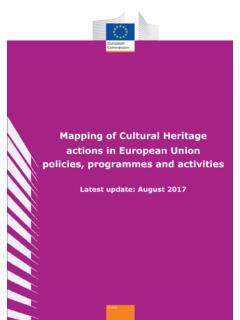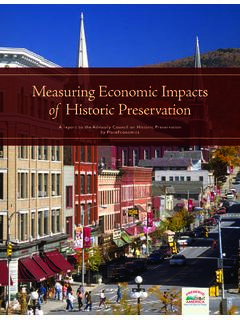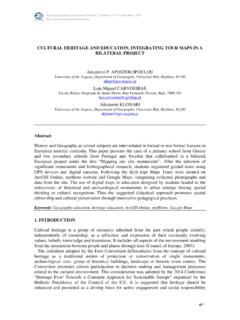Transcription of Sustainable Preservation GHF’s Model for Community ...
1 Saving Our Global HeritageSustainable PreservationGHF s Model for Community development - based ConservationGHF White Paper August, 2009 Sustainable Preservation GHF s Model for Community development - based conservation Table of ContentsI. IntroductionII. Threats to Sustainable Preservation Mass Tourism & Unplanned development Looting & Destruction ConflictIII. Opportunities for Sustainable Preservation Cultural Assets IV. Preservation by Design - GHF s Methodology Evaluation and Monitoring Community Engagement and development Planning and Design Scientific conservation Partnership DevelopmentV. ConclusionAppendices 1: GHF Case Study Pingyao, China 2: GHF Case Study Banteay Chhmar, Cambodia 3: GHF Case Study Kars, Turkey 4: GHF Case Study Mirador, Guatemala Sustainable Preservation GHF s Model for Community development - based ConservationI.
2 IntroductionIn the jungle of Northern Guatemala, just south of the Mexican border, lies a vast metropolis covering 100 square miles and once home to nearly 1 million people. Those fortunate enough to walk its streets today would find themselves beneath a thick canopy of ancient trees, surrounded by tall shapeless mounds and a cacophony of hoots and whistles from the cities newest inhabitants. This is Mirador, more than 2000 years old and the largest Preclassic Maya state known. And it is in peril. Nearby lies another great Maya city-state, Tikal, one of the most famous UNESCO World Heritage Sites in the Western Hemisphere and a shining example of Maya architecture, modern day conservation and Sustainable economic development . And it is Mirador, many cultural heritage sites are threatened by a host of factors.
3 Chief among these threats are the lack of economic opportunities for the local population. The realities of everyday life and the daily struggle for existence lead to looting, poaching, logging and slash and burn agriculture which threaten the integrity of these unique and irreplaceable cultural resources. Tikal is protected from these threats thanks to an integrated process of cultural Preservation and Sustainable development . The programs at Tikal have been so successful that the site generates thousands of jobs and more than $200 million of revenue for the country per year. It is to enable developments such as these that the Global Heritage Fund (GHF) was founded in mission of Global Heritage Fund is to save the earths most significant and endangered cultural heritage sites in developing countries and regions through scientific excellence and Community involvement.
4 For once a site or monument is gone; it is lost to humanity has developed a Sustainable methodology called Preservation by DesignTM, which protects historic and cultural resources by assisting in the Preservation of these sites, providing financial and technical resources and creating new economic opportunities for local communities. Preservation by Design takes each selected heritage site through an integrated process of evaluation and monitoring, planning and design, Community development and engagement, partnership development and conservation to provide enduring protection, management and financial support. Preservation by Design provides a methodology and Model for early-stage asset development , a process that engages the various stakeholders in this methodology, local capacity and initial seed and venture capital to bring these under-valued and nascent assets to a level that warrants larger-scale social and economic development investment.
5 This process allows GHF to avoid or mitigate many of the challenges inherent in cultural Preservation , including poverty, unchecked development , mass tourism and conflict. While the nature of and depth of involvement in each of GHF s projects differs, one theme runs throughout: that the monuments, art and architecture of our ancestors can, if respected, bring lasting cultural, social, and economic benefits to a society. This paper discusses the major challenges to Sustainable cultural heritage Preservation and also identifies solutions that make Preservation financially viable to local communities. Finally, this paper discusses Preservation by Design and how it provides GHF with the organizational tools and methodology to protect the past while creating new opportunities for present and future generations.
6 Sustainable Preservation GHF s Model for Community development - based ConservationII. Threats to Sustainable PreservationCultural Preservation and development are not without risk. Social disparities, political instabilities, weak economic conditions and natural disasters can threaten and destroy cultural heritage sites Since the UNESCO World Heritage Convention was adopted in 1972, hundreds of significant archaeological and historic sites have been lost to mass tourism, unplanned development , looting, neglect, conflict and disaster. These threats are aggravated by institutional weaknesses that can impede any coordinated or collective action by stakeholders interested in establishing Sustainable Preservation programs, and can irreparably destroy a cultural resource for present and future Tourism & Unplanned development Tourism directly and indirectly employs more than 215 million people worldwide, and generates approximately of the world s total economic activity1.
7 Tourism is the principal source of foreign currency revenue for 83% of developing countries and the primary source of foreign exchange in the 49 least developed countries2. In fact, Asian countries, which are home to two-thirds of the world s poor, have seen tourism receipts increase from $ billion dollars in 1990 to roughly $ billion dollars in 2002. While this increase in the number of tourists has been an overall positive trend for the developing world, there are also unintended negative consequences that threaten cultural and natural sites. The greatest challenge is to ensure that tourism does not destroy the very attractions that draw visitors in the first costs and problems associated with cultural heritage tourism can include damage to the environment, destruction and deterioration of cultural sites and monuments, escalating public administration costs, strains on infrastructure and significant declines in the quality of life for residents.
8 Necessary expenditures to support tourism include road construction and maintenance, security, sanitation, water, electric and associated infrastructure costs and increased services to maintain cultural and environmental assets, but in many developing countries, rapid growth of tourism, unplanned development , population growth and expansion of agriculture quickly and irreparably overwhelm existing social and economic systems. Furthermore, many countries lack the institutional capacity necessary to insure protection of heritage assets over the long-term. There exists a need to overcome weaknesses in institutional and organizational capacities, both on the national and local levels, and to create strong and enforceable policies and laws to insure adequate protections for core archeological sites and their buffer of negative impacts can be seen at the World Heritage Sites of Machu Picchu, Peru and Angkor, Cambodia.
9 At Machu Picchu, where yearly visits by tourists have nearly doubled in the past ten years, conservationists have advised UNESCO's World Heritage Committee that landslides, fires and haphazard development are threatening the site and that unregulated growth, including a boom in hotel and restaurant construction in the nearby town of Aguas Calientes, is putting pressure on erosion-prone riverbanks resulting in slope instability and water quality issues. According to heritage experts carrying out restoration work at the temples of Angkor, one of the largest religious cultural heritage sites in the world, an increasing number of new hotels and other urban development are drawing so much groundwater from beneath the site that experts 1 World Travel & Tourism Council (2006) The Travel and Tourism Economic Research.
10 2 Harris R., Vogel D. (2002): E-Commerce for Community based Tourism in Developing Countries. Sustainable Preservation GHF s Model for Community development - based Conservationbelieve that the foundations of the site are in danger of collapse. In addition, the nearby town of Siem Reap is feeling the effects of increased pollution and the loss of historical structures as new, modern amenities are built to attract and serve tourists. Looting & Neglect While Preservation initiatives can deliver the necessary financial and technical management capacity to conserve cultural heritage assets, successful long-term sustainability is ultimately dependant on local Community engagement and stewardship. In many communities around the world, the daily struggle for survival means using any and all resources at one s disposal.
